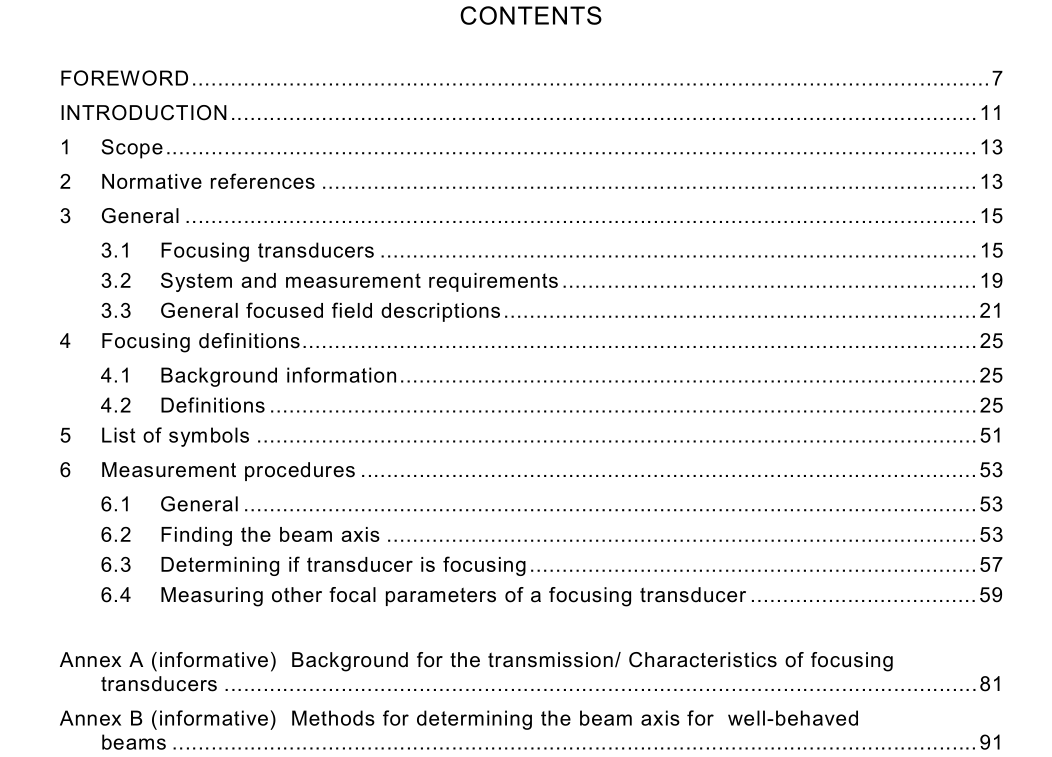IEC 61828 pdf download

IEC 61828 pdf download.Ultrasonics – Focusing transducers – Definitions and measurement methods for the transmitted fields
1 Scope
This International Standard − provides definitions for the transmitted field characteristics of focusing transducers for applications in medical ultrasound; − relates these definitions to theoretical descriptions, design, and measurement of the transmitted fields of focusing transducers; − gives measurement methods for obtaining defined characteristics of focusing transducers; − specifies beam axis alignment methods appropriate for focusing transducers. This International Standard relates to focusing ultrasonic transducers operating in the frequency range appropriate to medical ultrasound (0,5 MHz to 40 MHz) for both therapeutic and diagnostic applications. It shows how the characteristics of the transmitted field of transducers may be described from the point of view of design, as well as measured by someone with no prior knowledge of the construction details of a particular device. The radiated ultrasound field for a specified excitation is measured by a hydrophone in either a standard test medium (for example, water) or in a given medium. The standard applies only to media where the field behaviour is essentially like that in a fluid (i.e. where the influence of shear waves and elastic anisotropy is small), including soft tissues and tissue-mimicking gels. Any aspects of the field that affect their theoretical description or are important in design are also included. These definitions would have use in scientific communications, system design and description of the performance and safety of systems using these devices. This standard incorporates definitions from other related standards 1 where possible, and supplies new, more specific terminology, both for defining focusing characteristics and for providing a basis for measurement of these characteristics.
3 General
The information contained in this clause is an introduction to the definitions given in clause 4 and the measurement methods given in clause 6. 3.1 Focusing transducers The term “focusing transducer” 2 is commonly used for a device which has a smaller beamwidth in some regions of the field than a device which is “non-focusing”. A “non- focusing transducer” can still have a natural focus, so it is necessary to distinguish a focusing transducer as having a greater concentration of pressure amplitude (for a given power output) than a non-focusing transducer at its natural focus. For example, a non- focusing transducer made of a simple disc of uniformly poled piezoelectric material has a beam whose intensity at its natural focus can be as much as four times the average intensity at the source, and whose –6 dB beamwidth can be approximately half of that at the source. A definition of a focusing transducer is given in 4.2.33 to make a quantitative distinction between focusing and non-focusing transducers. 3.1.1 Focusing methods The simplest means of intentionally focusing an ultrasonic transducer, borrowed from analogous optical principles, is that of shaping the ultrasonic transducer into a concave form or adding to it a physical lens as illustrated in figure 1 . In the top part of this figure, a transducer curved with a radius R is shown focusing to the centre of curvature, where R is positive by convention. By the geometrical-optics approximation, the focal length F is equal to R and hence is also positive. In the middle of figure 1 is shown a transducer with a plano- concave lens made of a material with longitudinal velocity, c L , which is curved on one side with a radius, R LENS , and radiates into a medium in which the velocity is c W . In acoustics, c W is typically less than c L , i.e., the index of refraction n (equal to c W /c L ) is less than 1 . When this is true, the radius is considered to be negative and the focal length,









